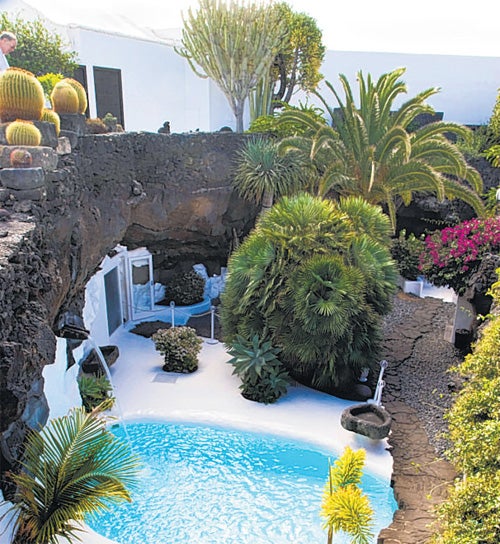Art in the landscape César Manrique
Celebrated artist put island’s natural curves and caves on a global stage

Your support helps us to tell the story
From reproductive rights to climate change to Big Tech, The Independent is on the ground when the story is developing. Whether it's investigating the financials of Elon Musk's pro-Trump PAC or producing our latest documentary, 'The A Word', which shines a light on the American women fighting for reproductive rights, we know how important it is to parse out the facts from the messaging.
At such a critical moment in US history, we need reporters on the ground. Your donation allows us to keep sending journalists to speak to both sides of the story.
The Independent is trusted by Americans across the entire political spectrum. And unlike many other quality news outlets, we choose not to lock Americans out of our reporting and analysis with paywalls. We believe quality journalism should be available to everyone, paid for by those who can afford it.
Your support makes all the difference.When La Corona in northern Lanzarote erupted around 6,500 years ago, it created one of the most interesting volcanic cave systems in the world. Well after the top layers of lava had begun to solidify, the faster-moving lava below kept on flowing, |carving out underground channels as wide as a city street. Pockets of trapped gas became subterranean chambers, some higher than a house.
Today, at ground level, the Malpaís de la Corona is a beautiful wilderness of ancient lava, softened with lichen and a fuzz of hardy, succulent plants. Follow the roads that encircle these badlands and there’s no reason to guess what lies beneath. But the indigenous islanders knew about the caves – they used them as a refuge from slave-hunters and pirates.
Lanzarote’s celebrated artist, designer and conservationist, César Manrique, knew about the caves, too. In the mid-Sixties, he set about transforming one section into a social and cultural venue called Jameos del Agua. His plan was to bring it to life |as “the most beautiful nightclub in the world”.
In reality, he went several stages further. Yes, there’s a perfect little stone-and-whitewash bar and dancefloor, plus a stage where folkloric dancers swirl and clap on Friday and Saturday nights. But there’s also a dramatic restaurant at the foot of |a subterranean cliff, with zingy green foliage tumbling down from above. Beyond lies a mysterious lagoon; further on there’s |a museum of vulcanology.
The biggest surprise is the garden. Manrique created an oasis in a jameo, a former lava bubble the ceiling of which had collapsed to leave a natural sunken amphitheatre. He stuffed its sides with cacti and palms and graced the centre with one of his signature creations, a glossy white pool with luscious curves.
Jameos del Agua was one of the first and most flamboyant of Manrique’s big creative projects, each of which takes a natural setting and enhances it with a little magic. A cactus garden, |a clifftop lookout and a volcano-powered restaurant would follow. From the Sixties to his death in 1992, he was key to the cultural coming-of-age that marked Lanzarote’s growth into an island with architectural integrity and clout.
It was Manrique who codified the Lanzarote aesthetic of beautifully simple, whitewashed buildings set against stark volcanic terrain. Fearful that an “avalanche of tourism” would destroy everything, he drew up guidelines. These have since influenced every local development project, from the restoration of ancient fincas to the construction of five-star resorts.
One of his most intimate creations, and one which best reflects his passionate respect for the island’s unusual landscapes, was his own home, the Taro de Tahiche. Now housing the art and conservation foundation that bears his name, it’s a fascinating building, built on a lava flow that dates back to the 1730s. Its ground floor façade resembles a traditional Canarian house, but step inside and you find yourself in a light-drenched, glass-walled space hung with greats such as Picasso and Miró. Downstairs there’s a playboy lair sculpted out of lava bubbles, and a delicious little pool-party zone.
In the main gallery, panoramic windows offer lava views so dramatic they threaten to upstage the paintings and photography. But to Manrique, this was all part of the plan: he saw nature as the ultimate artist, and himself as just the framemaker. “For me, this island is the most beautiful place on Earth,” he said, “and if others could see it through my eyes, then they’d feel the same. That’s what made me decide to show the world the beauty of Lanzarote.”
* Jameos del Agua (00 34 928 848 020; centrosturisticos.com). Open daily 10am–6.30pm, €8. Evening entrance Tue, Fri and Sat, 7pm–2am, €9.
* Fundación César Manrique (00 34 928 843 138; fcmanrique.org). Open Nov–Jun, Mon–Sat, 10am–6pm; Sun, 10am–3pm; Jul–Oct, daily, 10am–7pm, €8.
Join our commenting forum
Join thought-provoking conversations, follow other Independent readers and see their replies
Comments